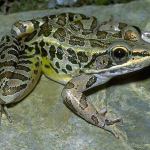Genus Species: Lithobates palustris
Size: 1¾ - 3½”
Location: Mainly found in the Ozarks and Coastal Plain, but scattered elsewhere.
Advertisement Call: Very quiet, low pitched, 1-2 second snore
Description:
This frog is your friend. It is very sensitive to the quality of the water, so if you have them around, you probably have clean water. The spots on the back of this frog tend to be rectangular as opposed to the Southern Leopard Frog which has more polygonal shapes. Also, notice the two dorsolateral folds along its back.
The skin of a pickerel frog can emit a toxic secretion for protection. This toxin can be deadly to other frogs and few snakes will eat pickerel frogs. Whenever you handle frogs or toads be careful to avoid contact with your eyes, nose, or mouth, and wash your hands thoroughly immediately afterward.
Interesting Fact: Frogs eyes on the sides of their heads can see forwards and backwards. Toads eyes face more forward.
These frogs are early breeders - from February to June. The males sometimes call from under water! The females lay about 2,000 eggs which cling to submerged vegetation. Tadpoles emerge in 10 days and morph into frogs in about three months. They are found on the edges of wetlands and around caves.
The pickerel frog is a member of the Ranidae (True Frog) family - one of the New Frogs (Neobatrachia). Memory aid for the call: Imagine a pickerel fisherman who has fallen asleep - so he is snoring!
Click for more about Pickerel Frogs at Herps of Arkansas.

